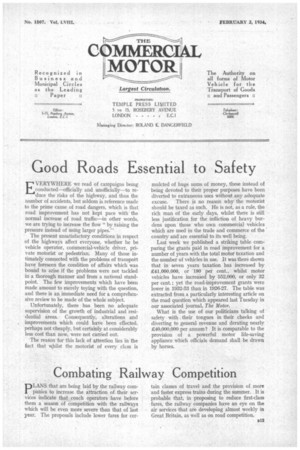Combating Railway Competition
Page 27

Page 28

If you've noticed an error in this article please click here to report it so we can fix it.
PLANS that are being laid by the railway companies to increase the attraction of: their services indiCate that coach operators have before them a season of competition with the railways which will be even more severe than that of last year. The proposals include lower fares for cer tain classes of travel and the provision of more and faster express trains during the summer. It is probable that; in proposing to reduce first-class fares, the railway companies have an eye on the air services that are developing almost weekly in Great Britain, as well as on road competition. These schemes emphasize the importance of the forthcoming National Road Passenger Transport Week, and the vital need for every public-servicevehicle operator to use his influence to make it a success. Moreover, national publicity on behalf of the road interests must not be allowed to lapse at the end of the intensive campaign. Steps should be taken to establish a fund with which to maintain a suitable output of advertising matter, and every operator in the country, on both the passenger and goods sides, should make a small contribution to it. Such a fund could be administered by a committee representative of all road-transport interests.
The foreword to the second annual reports of the Traffic Commissioners, 1932-1933, showed that there are some 6.000 public-service-vehicle operators in the country, owning between them over 46,000 coaches and buses. If every proprietor contributed an average of 1s. per 'week to the publicity fund, a sum of approximately £15,600 a year would be obtained, with which much valuable propaganda could be undertaken, whilst the bestknown counsel could be briefed, if necessary, to fight cases in which vital matters of principle were involved. Incidentally, this figure represents the sum obtainable only froth coach and bus operators. If hauliers could be persuaded to participate, an ample 2-nount could be collected for a really comprehensive campaign. The salient feature of any such scheme is Co-operation, and only by operators pulling -together can any appreciable increase in public support be secured.
Better Lighting Needed For Level Crossings
mANY level-crossing gates are inadequately marked at night by warning lights. In some cases, the oblique angle between the line of the railway and that of the road, or the fact that the road approaches by a curve, makes it desirable to employ especially clear indications as to the nature of the obstruction, and it is quite feasible that the single red light commonly used may, in certain conditions, be mistaken for the tail lamp of a vehicle travelling along the road. In such cases, more than one red light is necessary, or a modest flood-lighting system should be employed.
A few days ago a motorist was sentenced to three months' imprisonment in the Second Division, and was disqualified for three years from holding a driving licence, on account of what was alleged to be dangerous driving. He said that he did not see the red light on certain level-crossing gates until 20 yds. away, with the result that he crashed through the gates and came to rest across the railway line. A more serious accident was avoided only by a signalman stopping an approaching train by running down the track with a red light.




























































































